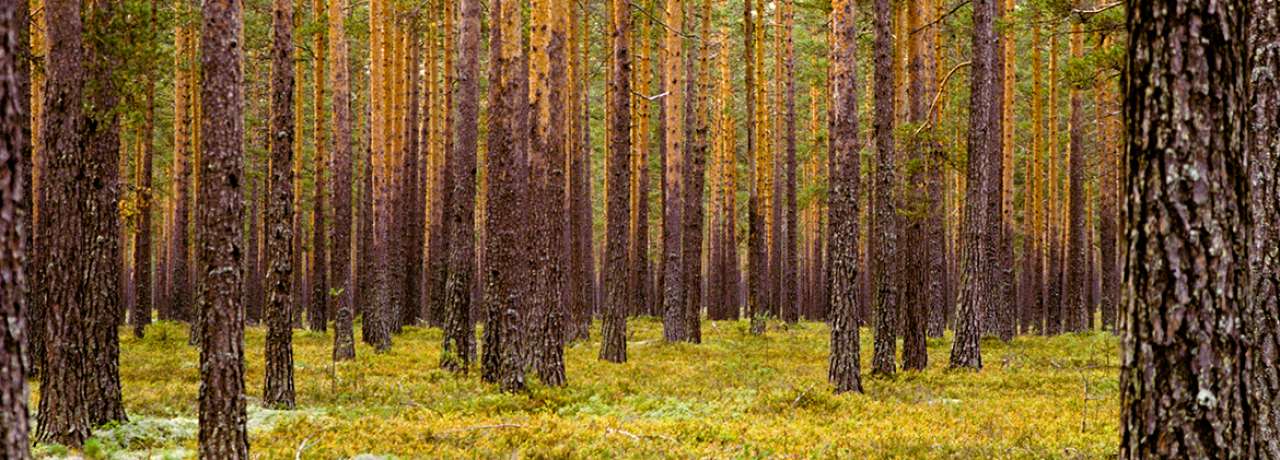
Forest Management and Silviculture
Forest management encompasses all measures implemented in the forest during a rotation, such as regeneration, young stand tending, thinning, fertilization and final harvesting. Through forest management we can influence the growth and development of the forest. The aim is to implement a management strategy that provides good economic returns and optimal timber production, while also taking into account the importance of the forest for climate and the environment.

Production of Tree Seedlings
The cultivation of tree seedlings is a specialized area that requires knowledge of many disciplines. The aim is to deliver robust seedlings that establish themselves well after planting in the forest and the cultivator must know all the different factors that influence the tree's properties.
Planting and Natural Regeneration
After a harvest, a new forest will be established. For the regeneration to be biologically and economically optimal, both planting and natural regeneration must be carried out properly. Forests can be regenerated by planting, sowing and/or natural regenerating from seeds. In Norway, planting is most common in spruce forests, while the majority of pine forests are naturally regenerated.
Young Stand Tending
Tending of juvenile forests is important for ensuring good production and choice in the future. Young stand tending includes both the removal of hardwood trees and density control of the main tree species. Young stand tending should take place when the average tree height is between 1 and 5 meters tall.
Thinning
Thinning is the removal of a certain proportion of trees in a forest and is generally implemented in young forests which have not yet reached maturity. The main goal of thinning is to reduce competition by removing poorly developed and/or unfavorable tree species for the purpose of increasing the production of the best crop trees.
Fertilization
Fertilizing with nitrogen provides a quick effect on forest growth. When properly implemented, fertilization can increase timber volume, providing a higher proportion of saw timber and better economic gains for forest owners, while providing a positive climate effect.
Regeneration Harvest
A regeneration harvest incorporates the removal of the crop trees while leaving some trees to facilitate the regeneration of new trees on the area. After harvesting, a forest owner has a duty to regenerate the forest.
Adapting to climate change
Forest management should be adapted to climate change. For example, when regenerating a forest, it is important to choose the right seed or plant material which can utilize a longer growing season without increasing the risk of damage. Through proper young stand tending, one can create a robust forest that can better withstand wind and snow in risky areas. NIBIO monitors the forest's development and researches measures that can be used to adapt to a changing climate.
Climate Measures in Forestry
Growing forests absorb CO2 through photosynthesis. Today, Norwegian forests have a net intake corresponding to about half of our man-made greenhouse gas emissions. Among other things, measures that can increase carbon storage in the forest are:
- Use of improved plant material
- Increased planting density
- Forest fertilization
- Planting of forest in new areas
- Tree species change in suitable areas
- Optimal rotations
Wood from the forests can be used to replace fossil-fuel based products, and the above mentioned measures can be used to increase the supply of biomass. Some of the measures also have the potential to increase the timber quality, and thus could increase the substitution value by allowing a larger proportion to be used in long-lived products. Harvesting of wood from the forest also provides residual products through the value chain, from harvest residuals in the forest and beyond, which can be used for bioenergy, replacing energy from fossil fuels.
Foreign Tree Species
Under one percent of the productive forest area in Norway is dominated by foreign tree species. Originally, the purpose of planting foreign tree species in Norway was to test whether these species could produce timber of good quality and high volume production, preferably better than Norwegian tree species.
